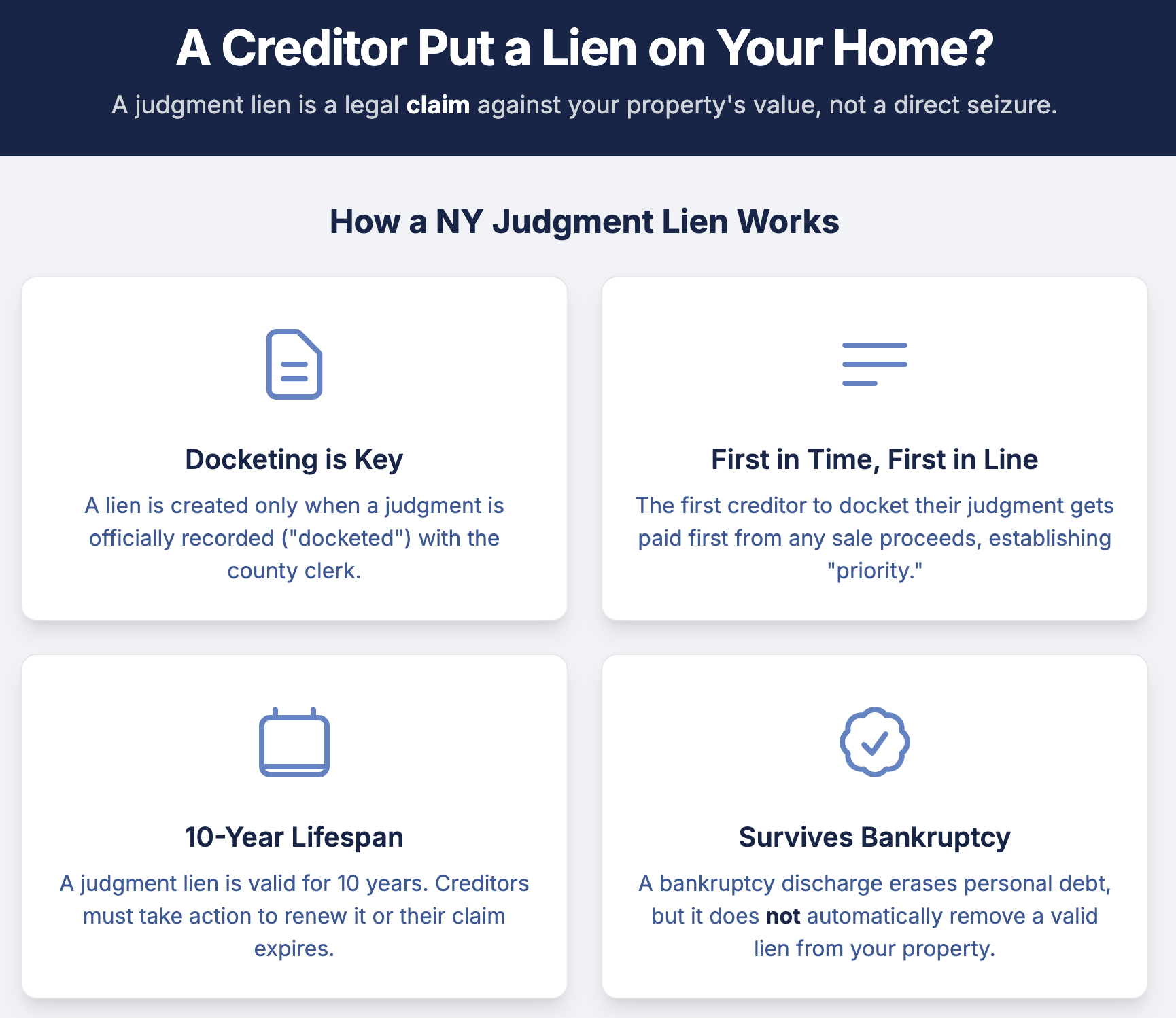In New York, a judgment lien on real property arises when the money judgment is docketed with the county clerk in the county where the property is located (not merely upon entry).
If you have been sued and either failed to formally respond (resulting in a default judgment) or were defeated in court (losing on the merits of the case), you become the judgment debtor. A docketed judgment lien attaches to the judgment debtor’s real-property interests in that county; enforcement is limited by exemptions (e.g., the homestead exemption), and the lien reaches only equity above the exempt amount.
A lien, generally, is defined as a legal right or interest that a creditor has in another's property, lasting usually until a debt or duty that it secures is satisfied.
A lien is imposed against a judgment debtor's nonexempt property. For a list of exempt personal property, see this blog. For exempt homestead property, see this blog.

How NY Judgment Liens Work: 13 Must-Know Points
- Docketing a judgment lien is straightforward; actual collection may require additional steps and time depending on the debtor’s equity and exemptions. Example: A creditor can easily file a lien against a debtor's property with minimal legal fees, rather than pursuing more complex enforcement methods.
- Typically, the creditor does not take possession of the property on which the lien has been obtained.[1] Explanation: The lien acts as a claim against the property's value, not a direct takeover of the property itself.
- A creditor is often paid on sale/refinance, but should monitor the 10-year lien period and timely renew/extend to preserve priority. Example: If a debtor decides to refinance their mortgaged home, the lien must be satisfied before the refinancing can proceed, ensuring payment to the creditor.
- A misspelling can prevent the lien from being created or from giving notice to third parties (which can protect a good-faith purchaser), but the underlying judgment remains valid. Do a title search to verify proper recordation) to protect a good-faith purchaser of the land subjected to the improperly indexed judgment. Example: A judgment filed against "Jon Smith" won't affect property owned by "John Smith," protecting an innocent buyer who purchases property from "John Smith."
- If you seek to enforce a judgment obtained in a different state, make sure your sister-state judgment is reduced to judgment and entered. File an authenticated sister-state judgment with the county clerk under CPLR 5402; once filed, it has the same effect as a NY Supreme Court judgment. Explanation: This means converting the out-of-state judgment into a local one, legally recognizing it in the state where enforcement is sought.
- A judgment lien on real property establishes priority over later claimants. Example: If a property is subject to multiple debts, the first recorded judgment lien takes precedence in being paid off over later ones.
- A judgment lien attaches to the debtor’s real property in the county where the judgment is docketed. Explanation: This may include land, buildings, and certain fixtures on the property in that county.
- A judgment lien attaches to the debtor's after-acquired property provided the judgment is docketed in the same county as the real property. Example: If the debtor buys new property in the same county after the lien is issued, the lien automatically applies to this new property.
- The judgment lien sticks to the property and assures priority to the judgment creditor as to after-acquired interests. Explanation: The lien remains with the property even if it changes hands, ensuring the creditor's claim is prioritized for any new interests in the property.
- A bankruptcy discharge generally doesn’t remove liens. A debtor can move under 11 U.S.C. § 522(f) to avoid a judicial lien to the extent it impairs an exemption; the 90-day preference rule (§ 547) is a different concept. Example: A debtor who files for bankruptcy cannot eliminate a lien that was perfected on their property three months before the bankruptcy filing.
- A judgment lien is less disruptive to a debtor's business life since there is no immediate physical taking; therefore this lien is less likely to trigger a bankruptcy filing for relief. Explanation: Because the debtor's assets aren't immediately seized, they can continue business operations, which lessens the financial strain that might otherwise lead to bankruptcy.
- Filing a notice of levy with the county clerk renders later transfers ineffective against the judgment creditor while the levy is outstanding. Example: This legal notice effectively prevents the sale or transfer of the property until the debt covered by the lien is paid off.
- Use CPLR § 5226 to require the debtor to make installment payments; to reach future rent from tenants, bring a CPLR § 5227 proceeding against the tenants. Example: If the debtor is a landlord, the creditor can obtain a court order to divert future rental income from tenants to satisfy the debt.
- See here how a docketed judgment becomes a judgment lien against real property.
Keep in mind, friends, that this post, along with all others, involves New York laws.
[1] Black's Law Dictionary, 1053 (10th ed 2014).


